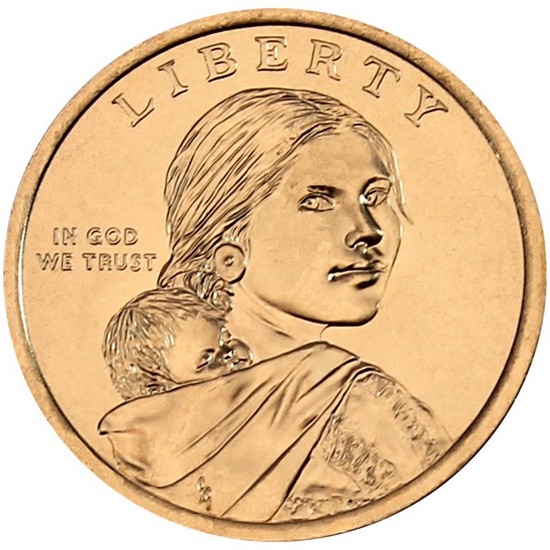
2015 Sacagawea Dollar
The 2015 release in the annual Native American Dollar series from the United States Mint, "Mohawk Ironworkers", is now available. The design commemorates the contributions of the Kahnawake Mohawk and Mohawk Akwesasne communities to the building of New York City and other skylines. These "high iron" construction workers helped with the building of many skyscrapers, including the Empire State Building. The reverse of the coin shows a Mohawk Ironworker reaching for an I-beam to help guide it into position as it swings down from above. The background displays a wide-angle, elevated view of the New York City skyline. To the right and left of the image is a depiction of a rivet (as found on I-beams). Inscribed below the worker’s foot is MOHAWK IRONWORKERS.
Since their initial launch in the year 2000, the famous Shoshone Indian woman Sacagawea has been featured on these Golden Dollars. From 2000-2008, the reverse of the Sacagawea Dollar coin remained the same – showing an eagle in flight surrounded by 17 stars to represent the states in the Union at the time of the Lewis and Clark expedition. Since 2009 the reverse has changed annually, with designs created to memorialize Native Americans (both individuals and tribes) and their contributions to the development and history of the United States. The coins were thus officially renamed Native American Dollars, although they are still commonly referred to as Sacagawea Dollars.
Previous designs in the Native American Dollar series include "Three Sisters" (2009), "Great Law of Peace" (2010), "Wampanoag Treaty" (2011), "Trade Routes in the 17th Century" (2012), "The Delaware Treaty" (2013) and "Native Hospitality" (2014). On the reverse of all years of the Sacagawea Dollar is inscribed UNITED STATES OF AMERICA and ONE DOLLAR (depicted on the newer Native American coins as $1). Also inscribed on the reverse from 2000-2008 was E PLURIBUS UNUM, but this inscription (along with the year and mint mark) was moved to the edge of the coin from 2009 to present date.
Golden Dollar coins originally came about as a concentrated effort to remedy the lack of acceptance of the Susan B. Anthony Dollar coins, which many people confused with quarters due to their similarities (size, color and reeded edge). The United States Dollar Coin Act of 1997, which birthed the Sacagawea Dollars, mandated that "The dollar coin shall be golden in color, have a distinctive edge, have tactile and visual features that make the denomination of the coin readily discernible...". These requirements led to the smooth edge, a wider rim and of course the golden color.
 A likeness of Sacagawea was chosen as the obverse for the first golden dollar coin series from amongst many initial concepts. It was felt that this young Native American guide and interpreter displayed the spirit of liberty, peace and freedom when as a teenager she played a huge role in leading the famous Lewis and Clark expedition successfully across the continental United States. The design was created by Glenna Goodacre, a well-known sculptor. Goodacre used a Shoshone college student named Randy’L He-Dow Teton as a model for the likeness. Similar to how she would have been seen while on the Lewis and Clark expedition, Sacagawea is shown with her infant son, Jean Baptiste, strapped to her back. Inscriptions on the obverse of the coin include LIBERTY and IN GOD WE TRUST. The year and mint mark also appeared on the obverse from 2000-2008, but were moved to the edge of the coin in 2009 (as mentioned above).
A likeness of Sacagawea was chosen as the obverse for the first golden dollar coin series from amongst many initial concepts. It was felt that this young Native American guide and interpreter displayed the spirit of liberty, peace and freedom when as a teenager she played a huge role in leading the famous Lewis and Clark expedition successfully across the continental United States. The design was created by Glenna Goodacre, a well-known sculptor. Goodacre used a Shoshone college student named Randy’L He-Dow Teton as a model for the likeness. Similar to how she would have been seen while on the Lewis and Clark expedition, Sacagawea is shown with her infant son, Jean Baptiste, strapped to her back. Inscriptions on the obverse of the coin include LIBERTY and IN GOD WE TRUST. The year and mint mark also appeared on the obverse from 2000-2008, but were moved to the edge of the coin in 2009 (as mentioned above).
While they still haven’t been widely accepted as commonly circulating coinage, Golden Dollars (including Sacagawea / Native American from 2000 to present and Presidential Dollars from 2007 to present) are popular with coin collectors. Start or continue your collection with the latest 2015 Native American Dollar – and as always, have fun building your collection!







